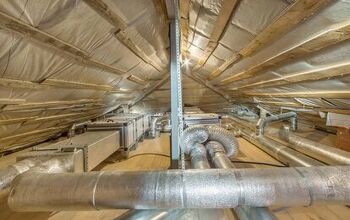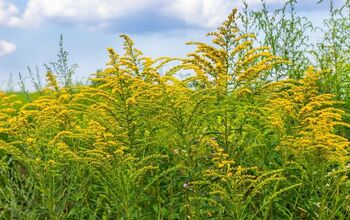Can Plants Cause Mold In The House?

Houseplants are rewarding to take care of, but doing so isn’t always easy. That’s because they are prone to many problems, some of which spill over into the rest of the house. So, can plants cause mold in the house?
Plants can cause mold to grow in the house, especially in poorly ventilated rooms with a humidity level of 55%-60%. Overwatering your plants can cause mold to grow on the soil and spread throughout the house. Run a dehumidifier as needed and set up ventilation fans in your indoor garden to prevent mold growth.
Check your houseplants for mold occasionally to catch and remove it before it spreads. Examine plants before you buy them from nurseries, as they may contain mold. Follow along as we explore everything you must know about how mold relates to indoor plants.
Why Is There Mold In My Indoor Garden?
Humidity
If there’s one thing that mold loves more than anything, it’s humidity. While humidity is great for houseplants, it can do just as much harm as good. Your grow room is at high risk of mold problems if the humidity level exceeds 55% to 60%.
Never set your humidifier higher than 55%, especially in a small indoor garden with minimal ventilation. You may even need to use a dehumidifier if your indoor garden is naturally humid. Running your air conditioner and opening windows can also reduce humidity when it’s cool outside.
Run your ceiling fan or set up an oscillating fan in your grow room to reduce humidity as well. Evapotranspiration is a process that plants undergo which increases humidity in a space. This is common with Jade plants, English ivy, lady palms, and rubber plants, among others.
Poor Airflow
Mold loves rooms with poor airflow, as that makes it easier for it to grow. Stagnant air makes a room more humid, and humidity is essential for mold to grow. That’s especially true if the room is already humid and full of mold spores.
You can combat mold if you set up several ventilation fans in your indoor garden. It’s also a great idea to set up your indoor plants in a room that is already well-ventilated. Keep your floor and wall vents open to improve airflow in the room.
Fans can also help protect plants from infections and bacteria that would otherwise harm them. Ventilation also comes in handy if you accidentally overwater your plants. The air movement can help dry the soil out to prevent root rot and mold.
Bad Drainage
Poor soil drainage can not only hinder plant growth, but it can also make it easy for mold to grow. The ideal soil drainage rate for many indoor plants is 1” to 3” per hour. This is fast enough that you can easily avoid root rot in most cases.
Soil that drains poorly is susceptible to root rot and mold because of how long the water sits. Poor soil drainage is often to blame when you find mold in the soil in your indoor garden. It may not seem like a big deal if it’s only in your soil, but it can spread.
Mold spores travel through the air and can even get into your HVAC system. This happens when your HVAC system turns on and spreads mold spores throughout your house. Repot your indoor plants with soil that drains quickly to prevent mold growth and protect the roots.
Excessive Watering
It’s all too easy to overwater your plants, but it’s a bad idea. Not only does overwatering harm your plants, but it can also create mold conditions. Overly wet soil takes a long time to dry out, and that makes it easy for mold to grow.
Research your houseplants and find out how much water they need. The watering needs vary between plants, so you may have to follow a different schedule with each one. Check the soil to see if it’s still damp before you water it.
Avoid watering an indoor plant that you’ve recently overwatered until the top inch of soil is dry. Otherwise, you may damage the roots, wash away nutrients, and contribute to mold growth. Overwatering and poor soil drainage are the main reasons why mold grows in soil and indoor gardens.
Contamination
Contamination is another major cause of mold in an indoor garden, and it’s hard to avoid. This can happen in several ways, but it’s most common when visiting plant nurseries. For example, you may unknowingly come into contact with moldy plants at a nursery.
Mold spores are hard to detect, even if you closely inspect a plant before buying it. It’s all too easy to accidentally buy a plant that has mold and bring it home. You can even bring mold home if spores land on your clothes.
This can also happen if your outdoor plants have mold that clings to your hands and clothes while gardening. You can easily transfer the mold spores to your indoor plants without realizing it. It’s important to thoroughly wash your hands after handling plants, whether you’re at home or a gardening store.
Can Mold Kill Plants?
Mold can kill plants if you don’t treat them right away. Plants may not receive all the nutrients from soil and fertilizer if mold is present. The leaves can eventually become discolored and even fall off before the plant itself dies.
White mold is especially harmful to plants, and it grows and spreads quickly. Carefully isolate and remove the mold, then take it out of your house. Otherwise, it can spread to other plants and areas in your home.
Is It Bad To Breathe In Mold From Plants?
Breathing in mold from plants is dangerous and carries many health risks. You can develop respiratory problems, and mold spores are especially harmful to people with existing respiratory issues. Inhaling mold can cause coughing, shortness of breath, sneezing, eye irritation, and skin irritation.
The best way to avoid breathing in mold from plants is to prevent mold growth. Act right away if you find mold in your indoor garden, or else the problem may get worse. We all breathe in mold spores at times, but you never want to regularly inhale contaminated air if your home is full of mold.
Summing It Up
Plants can cause mold in the house because of excessive humidity and overwatering. Some indoor gardens don’t have great ventilation, which contributes to mold growth as well. Use soil that drains well and carefully examine plants for mold before you bring them home to avoid contamination.
Related Guides:

Nick Durante is a professional writer with a primary focus on home improvement. When he is not writing about home improvement or taking on projects around the house, he likes to read and create art. He is always looking towards the newest trends in home improvement.
More by Nick Durante



























